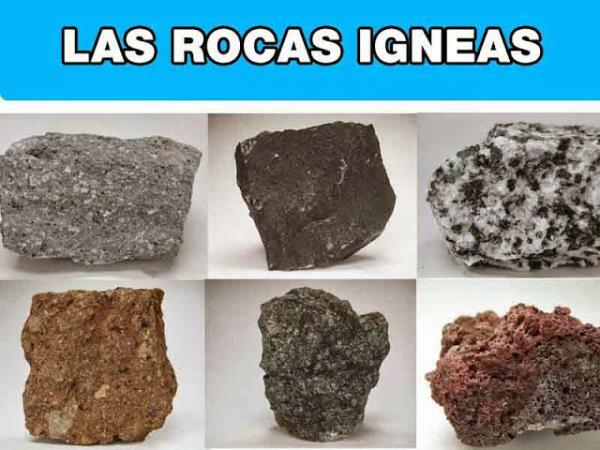ROCK classification

The rock study it has been something important in human life since ancient times. Humans, from the beginning of humanity, discovered which were the best rocks to make their constructions, where they could excavate or with which of them they should make their tools for hunting or the house.
All the stones that we can find on our planet can be classified according to different criteria: their origin, their use, their properties, etc. In this lesson from a TEACHER we will see the rock classification, which will allow us to know the different characteristics that make up our planet Earth.
Index
- Classification of rocks according to their geological origin
- Magmatic or igneous rocks
- Sedimentary rocks
- Metamorphic rocks
- Classification of rocks based on their properties
- Classification of rocks according to their use
Classification of rocks based on their geological origin.
The main classification of rocks used in science is that which groups together the
rocks according to their origin. This classification takes into account which forces are the cause of the rock formation, as well as the place where the rock is generated, the conditions necessary for the transformations to take place, etc.Main types of rocks according to their origin They are:
- Igneous or magmatic rocks
- Sedimentary rocks
- Metamorphic rocks

Image: Pinterest
Magmatic or igneous rocks.
The igneous or magmatic rocks They are one of the main classification groups for rocks. Within this group we find those rocks that are produced by the cooling and solidification of magma. This cooling can occur at different levels of depth.
- If the cooling of magma occurs within the earth's crust, rocks are produced plutonic or intrusive igneous. Some examples of igneous rocks are granite, gabbro, etc.
- If the rock is produced during the cooling of magma when it comes into contact with the atmosphere or the ocean, rocks are generated volcanic or extrusive igneous such as basalt, rhyolite or obsidian.
- A secondary type of igneous rocks are philonian, hypo-abyssal or subvolcanic rocks. Phylonian rocks cool in veins, that is, in irregularly traced fissures or flat-edged crevices and faults. Examples of igneous rocks are quartz, dunite, pegmatite, plagioclase, and orthoosa.

Image: Minerals Forum
Sedimentary rocks.
Sedimentary rocks are formed as a result of the action of atmospheric agents on rocks, since they existed before. This process of rock transformation is called weathering.
Weathering is caused by the physical, chemical and biological agents to which the rock is exposed; These agents weaken the rock, causing its fragmentation. The products or sediments generated from the rock are transported towards other places due to the wind and rivers, among others, where deposit gradually layered.
The rocks resulting from the weathering process are the sedimentary rocks, which can be of type:
- Clastic such as sandstone, grauvaca and conglomerate
- Chemical or evaporitic such as limestone, gypsum, and halite
- Of organic type such as anthracite, coal, peat and asphalt.

Image: Minerals Forum
Metamorphic rocks.
The last rock classification group is that of metamorphic rocks. Metamorphic rocks are generated when igneous or sedimentary rocks are subjected to long periods of time to heat, humidity and / or pressure. Therefore, it is said that metamorphic rocks originate inside the earth's crust due to the action of high temperatures and / or high pressures.
In general, this is how granite is "transformed" into gneiss, limestone becomes marble, and shale becomes slate. It is unusual to find metamorphic rocks in geologically young territories, since the rocks have not had time to suffer the forces that caused this transformation; instead, metamorphic rocks are common rocks and abundant in geologically ancient territories like Cordilleras like that of the Andes.

Image: Minerals Forum
Classification of rocks based on their properties.
Another especially useful classification of rocks is one that takes into account their properties. This classification is especially useful when we pretend use the rock for a specific purpose, such as construction, decoration, etc.
The classification of rocks according to their properties gives rise to two main groups: cemented rocks and crystalline rocks.
- The cemented rocks They are rocks of sedimentary origin, characterized by the presence of a cement that binds the grains of the matrix, for example: limestone, sandstone and calcarenite.
- On the other hand, crystalline rocks are those formed by mineral grains (crystals) in direct contact with each other. This group includes both magmatic and metamorphic rocks and we can find two subgroups: massive and foliar. Examples of massive crystalline rocks are granite and marbles while some examples of foliar rocks are shales.
Classification of rocks according to their use.
One of the most intuitive classifications of rocks is their classification according to the use that humans make of them. Following this criterion, rocks can be classified into:
- Construction rocks: They are those rocks that are used for the construction of different structures. Within this group we can find rocks for structural use (for the construction of ashlars, walls, etc.) and for use in cladding (pavements, roofs, cladding, etc.)
- Ornamental rocks: They are all those rocks for decorative use, integrated or not in buildings or higher structures. They are rocks worked with an aesthetic purpose such as granite, marble, etc.
- Rocks used in utensils for man. Within them we can find different subtypes, depending on its purpose.
- Crushed stones: aggregates, rubble, aggregates, etc. which are widely used in construction as filling material.

If you want to read more articles similar to Rock classification, we recommend that you enter our category of geology.
Bibliography
- Borreguero Rolo, J.A (s.f) Rock Classification. CienciasNaturales.com Recovered from: https://cienciasnaturales.es/rocas.html
- University of Costa Rica (January 23, 2019) What types of rock exist? Recovered from: https://rsn.ucr.ac.cr/documentos/educativos/geologia/2278-tipos-de-roca
- Universidad Pablo de Olavide (s.f) Rocks: Types and properties. Recovered from: https://www.upo.es/tym/WebCT/Materiales/page_03.htm



